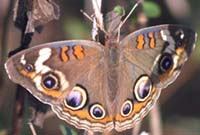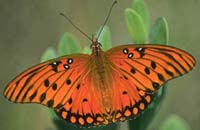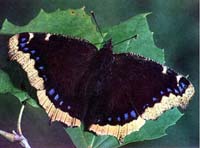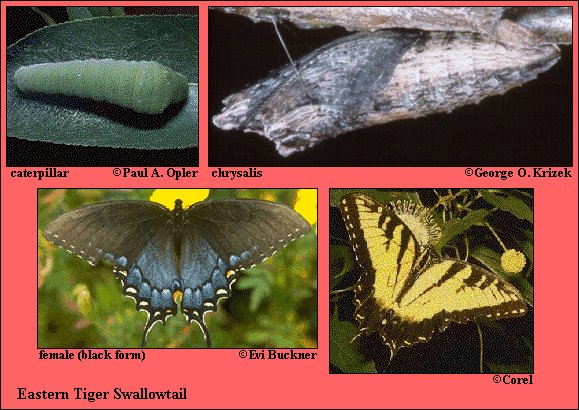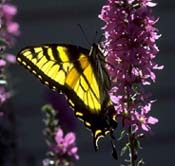CLAW Zine | Rainbow Chapel | CLAW
Science College, General Science Dept Hunting for Flying Flowers
or How to Become a Butterfly Watcher

My name is SassyJazmine and I will be your teacher for this class
Gather around kitties,because we are going to study the beautiful butterfly. We are going to cover some of the areas that you will need to know to become a butterfly watcher and answer some of the questions you may have, like where the butterfly goes when it rains
What you need for Butterfly watching
For better Butterfly watching you need a good pair of binoculars, a field guide, you need to find out where to find the butterflies, then you go watch them. It would be good to keep a list of all the different ones that you find. What is a butterfly?
Butterflies and moths are a group of insects called Lepidoptera. Like all insects, butterflies and moths have a head, thorax, abdomen, two antennae, and six legs, they have four wings that are almost always covered by colored scales, and a coiled proboscis for drinking liquids such as flower nectar. The Butterfly is found on all continents except Antarctica, it is to cold there for them, and scientists figure that there are approximately 15,000 species of butterflies and about 250,000 species of moths. There are still thousands of moth and butterflies that have not been found or described by scientists. In the United States and Canada, more than 750 species of butterflies and 11,000 species of moths have been recorded. Many species of moths and a few kinds of butterflies are still being discovered. There is much to be learned. Butterflies are mostly brightly colored day-flying insects with long clubbed antennae, and most moths fly at night and lack clubs at the end of their antennae. Perhaps the best answer that matches our current knowledge is just to say that butterflies are "fancy moths." Where to find the butterfly
Butterflies and moths are found during the warmer months of the year in many different environments. In most places, May to August are the best months, and you will do well looking in sunny exposed places with low plants. Many national parks, wildlife refuges, or other wild places are usually rich in butterfly species. Your local city or county park may have planted a butterfly garden to attract butterflies in the summer or you may want to visit the nearest insect zoo or butterfly house where hundreds of living exotic insects and butterflies are on display. They like to drink the nectar in the spring from Dandelion, Blueberries, Blackberries, Dewberries or Wild Plums. Nectar sources for Butterflies during the Summer are from Milkweed, Dogbanes, Sumacs, Cone flowers, Thistles, French Marigold or Butterfly Bush. In the fall their nectar source is Asters, Joe-pye Weeds, Goldenrod's, Blazing-stars and Iron weeds. It is also recommended that you grow your own Butterfly Garden so you can easily observe them from your own back yard. How can I catch a butterfly or moth?
The best way to "catch" a butterfly or moth is to photograph it, or raise it from the caterpillar stage. Then when the butterfly or moth hatches you can watch it and then let it go. Some stores have kits with a butterfly net that you can use to catch the them, but I think a picture would be much nicer. Since most moths are attracted to lights, you can find moths at porch lights in the evening, but be sure to use a white bulb, not a yellow one. Keeping a butterfly or moth collection requires that you follow special techniques and lots of care. Today, many kitties prefer to watch butterflies and moths with binoculars or to photograph the living insects. Photographing a live butterfly in nature can be more challenging than netting one, and you can keep your "collection" in a photo album. Why are butterfly and moth wings so delicate?
Butterfly and moth wings are made of thin layers of chitin--the same hardened protein that makes up their outside body--and are covered with thousands of tiny scales that lend color to the wings. The wings are strengthened by a system of veins. The wings have to be strong enough to support the body in the air, but still flexible enough for flight movements. How to raise a caterpillar
To raise a caterpillar through the chrysalis or pupa stage to the adult moth or butterfly is an excellent lesson about insect metamorphosis. All you need is a caterpillar, some of its favored food, and a suitable container. You can find caterpillars on most plants during the spring and early summer. Put the caterpillar and a few fresh leaves in a wide mouth jar or plastic shoe box. Cover the jar mouth with netting or a piece of nylon. Every day change the leaves and provide dry paper towels to help prevent mold. You can put in pencil-size twigs upon which the caterpillar can attach its chrysalis or silken cocoon. The insect will hatch in 10-14 days. Before releasing it you can photograph your prize Butterfly. Where do butterflies go when it rains?
Butterflies hide when it rains. They usually go to the same places they do for the night. Some butterflies hide under large leaves, some crawl down into the thick leaves or under rocks, and some just sit head down on grass stems or bushes with wings held tightly to their bodies. If the rains are exceptionally hard or of long duration many of the butterflies become pretty tattered. Do caterpillars have ears?
No, caterpillars do not have ears. In fact only some moths have "ears". These are not easily seen. Many adult moths and butterflies have motion stability sensors in their antennae.
That is all for the class today kitties
Now, on to the Exam

